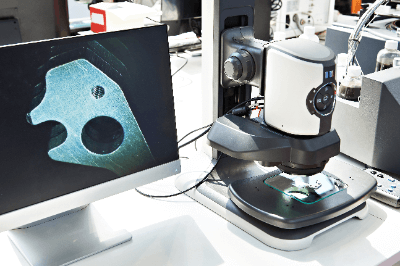What Is a Digital Microscope?

A digital microscope is an optical device that uses lenses to magnify objects and outputs images to a monitor for observation.
Equipped with multiple objective lenses, digital microscopes offer higher magnifications than single-lens models. Unlike optical microscopes that require eyepieces for viewing, digital microscopes project magnified images directly onto monitors, offering a variety of models from affordable to advanced industrial-grade options.
Uses of Digital Microscopes
Digital microscopes are widely used in diverse industries for their ability to magnify at higher levels than traditional optical microscopes and share images on monitors. In the electronics and semiconductor sectors, they are essential for quality inspection and research. In the medical field, these microscopes aid in cell observation related to pharmaceuticals and healthcare.
Principles of Digital Microscopes
Digital microscopes use an objective lens to create a magnified image of the object, which is captured by a camera. Modern objective lenses typically use compound lenses to minimize distortions known as aberrations.
1. Magnification
Magnification in digital microscopes is determined by multiplying the optical magnification of the camera’s lens by the monitor’s magnification, which is derived from its size and the imaging sensor’s size. While higher optical magnification facilitates greater enlargement, it may decrease resolution and image brightness. Selecting suitable cameras and monitors for the lens is crucial, as monitor size affects magnification but not necessarily image sharpness.
2. Depth of Field
Digital microscopes offer a significant advantage in depth of field compared to optical microscopes. This characteristic simplifies focusing and reduces the need for adjustments when changing magnifications, thanks to the use of deep-depth zoom lenses.
Types of Digital Microscopes
Digital microscopes come in desktop and handheld formats:
1. Desktop Digital Microscopes
Designed for detailed observations on a desk, this type is ideal for extended research, such as examining microorganisms on a stage. It can connect to large monitors, allowing multiple viewers, and is commonly used in university and corporate research.
2. Handheld Digital Microscopes
Suitable for field studies, handheld models enable on-site observations. While great for simple surveys, they are not ideal for in-depth studies.
Structure of Digital Microscopes
A digital microscope typically includes a light source, objective lens, camera, and monitor. Here’s a closer look at the light source and objective lens:
1. Light Source
The light is focused by a condenser lens, passes through the object, and enters the objective lens. Bright-field illumination, common in digital microscopes, uniformly illuminates the object for observing fine structures. Dark-field illumination, on the other hand, is used for observing transparent or very small objects.
2. Objective Lens
This lens first forms the image of the observed object. A higher numerical aperture in the lens allows more light collection, improving resolution, which is vital for distinguishing fine details in microscopic objects. Thus, selecting a microscope with a high numerical aperture is important for achieving high-resolution imaging.